Mallodeta is a monotypic moth genus in the family Erebidae described by Arthur Gardiner Butler in 1876. Its single species, Mallodeta clavata, was described by Francis Walker in 1854. It is found in Brazil and Paraguay.

Phoenicoprocta is a genus of tiger moths in the family Erebidae. The genus was erected by Herbert Druce in 1898.
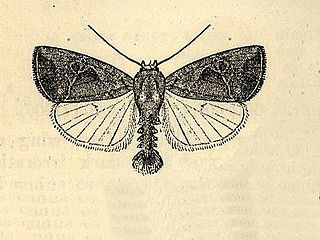
Elaphria nucicolora, the sugarcane midget, is a moth of the family Noctuidae. The species was first described by Achille Guenée in 1852. It is found from the south-eastern United States, through Guadeloupe, Jamaica and Puerto Rico to tropical South America. It is also present on the Hawaiian islands of Oahu, Maui and Hawaii.
Lepidomys irrenosa is a species of snout moth in the genus Lepidomys. It was described by Achille Guenée in 1852 and is known from the United States, including Florida, Georgia and South Carolina. It is also found on Cuba.

Elaphria agrotina is a moth of the family Noctuidae first described by Achille Guenée in 1852. It is found from North America, through Central America, the Antilles and Cuba to Brazil and Argentina.
Eutelia furcata, the Florida eutelia moth, is a moth of the family Noctuidae. The species was first described by Francis Walker in 1865. It is found from the southern United States to Mexico, Cuba, Puerto Rico and Central America.
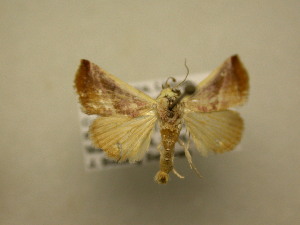
Eublemma cinnamomea is a species of moth of the family Erebidae first described by Gottlieb August Wilhelm Herrich-Schäffer in 1868. It is widespread in the New World tropics from the southern United States south to Argentina.
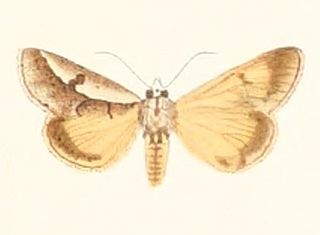
Euscirrhopterus poeyi, the pullback moth, is a moth of the family Noctuidae. The species was first described by Augustus Radcliffe Grote in 1866. It is found from southern Florida and Mexico, through Central America to Brazil. It is also found in the Caribbean, including Cuba.
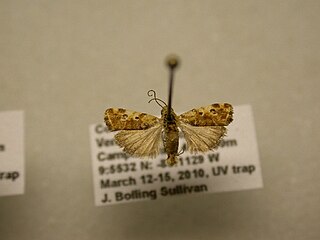
Spragueia perstructana is a moth of the family Noctuidae first described by Francis Walker in 1865. It is found from the United States, south to the Caribbean and Central America, including Costa Rica.
Leucania inconspicua is a moth of the family Noctuidae first described by Gottlieb August Wilhelm Herrich-Schäffer in 1868. It is found in Florida, Cuba, Puerto Rico, Jamaica, the Lesser Antilles and from Mexico to Brazil.
Melipotis famelica is a species of moth in the family Erebidae first described by Achille Guenée in 1852. The species is found from the southern United States to the Caribbean and Paraguay.
Eublemma recta, the straight-lined seed moth, is a moth of the family Erebidae. The species was first described by Achille Guenée in 1852. It is found in the United States from South Carolina to Florida and west to Texas. It is also found south to Argentina, on Cuba, Jamaica and Puerto Rico.
Melipotis januaris, the January melipotis moth, is a species of moth in the family Erebidae. It was first described by Achille Guenée in 1852. The species has a wide range in the New World and has been recorded from Saint Kitts, Montserrat, Dominica, Saint Lucia, Saint Vincent, Grenada, the Greater Antilles, Florida and from Mexico to Paraguay.

Spodoptera pulchella, the Caribbean armyworm moth, is a moth of the family Noctuidae found in Florida and Texas, Central America, the Greater Antilles, and the Bahamas. It was first described by Gottlieb August Wilhelm Herrich-Schäffer in 1868.
Leucania secta is a moth of the family Noctuidae first described by Gottlieb August Wilhelm Herrich-Schäffer in 1868. It is found on Cuba, Jamaica and the Bahamas.
Phoenicoprocta partheni is a moth of the subfamily Arctiinae. It was described by Johan Christian Fabricius in 1793. It is found on Haiti.
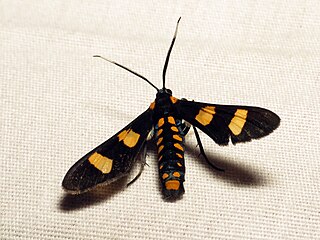
Phoenicoprocta hampsonii is a moth in the subfamily Arctiinae. It was described by William Barnes in 1904. It is found in the United States in south-eastern Arizona and in Mexico's Baja California.
Phoenicoprocta lydia, the Lydia tiger moth, is a moth in the subfamily Arctiinae. It was described by Herbert Druce in 1889. It is found in Mexico and southern Texas.
Phoenicoprocta thera is a moth in the subfamily Arctiinae. It was described by Herbert Druce in 1889. It is found in Mexico.
Phoenicoprocta vacillans is a moth in the subfamily Arctiinae. It was described by Francis Walker in 1856. It is found in Colombia and the Brazilian states of São Paulo and Santa Catarina.







